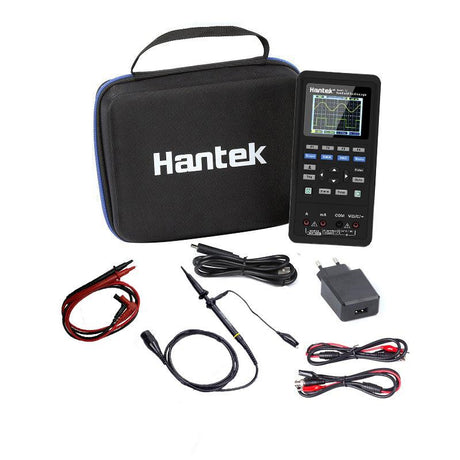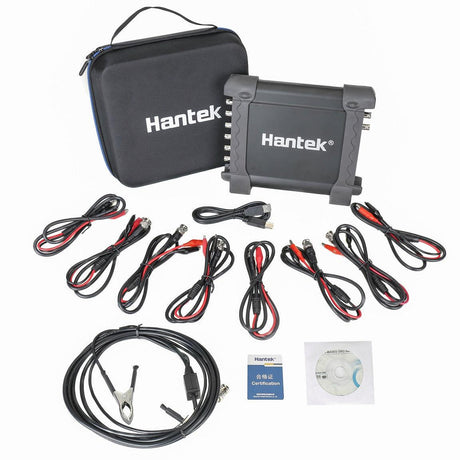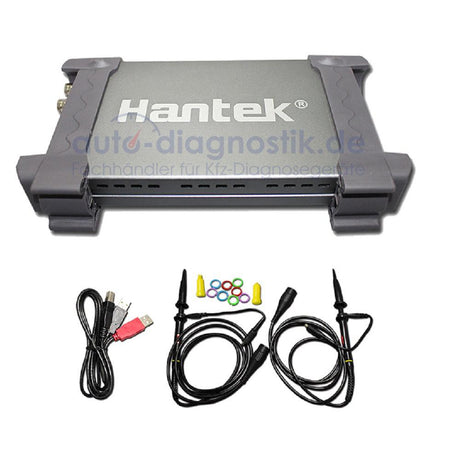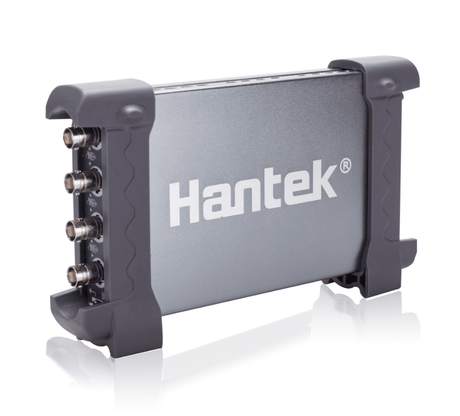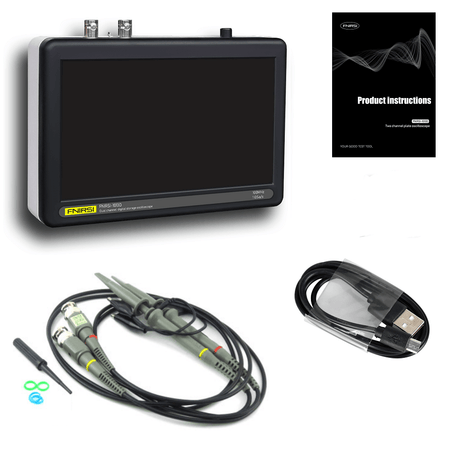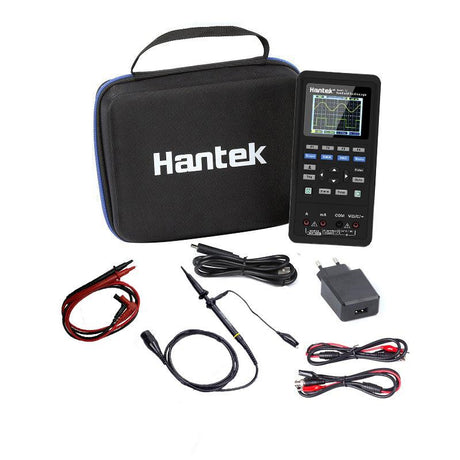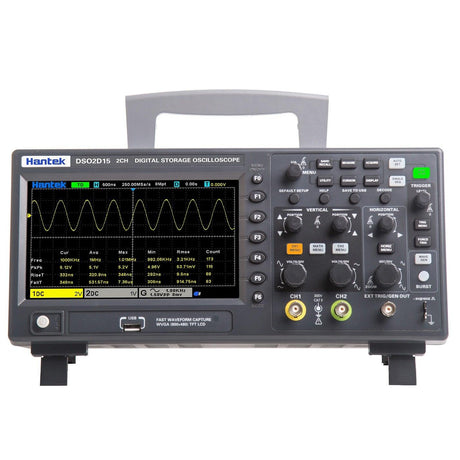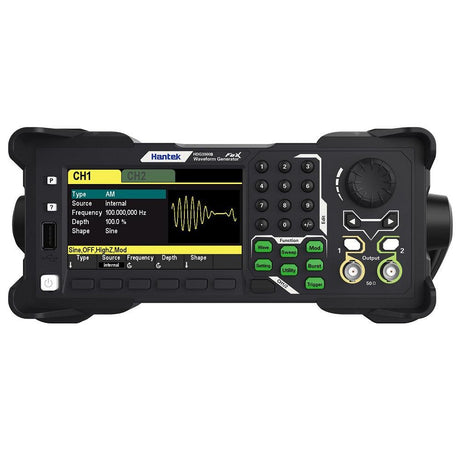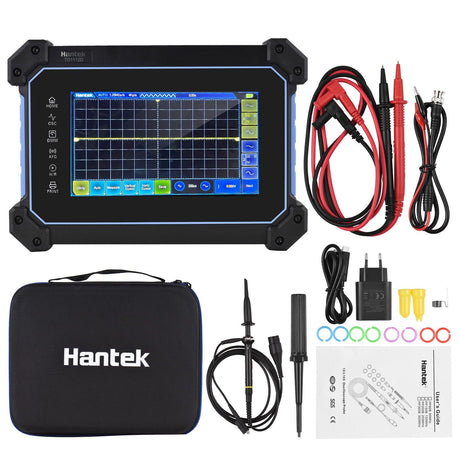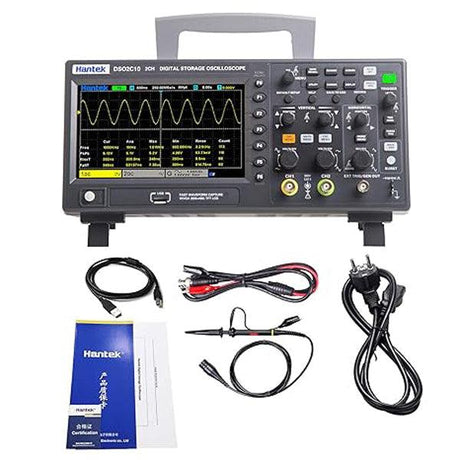Hantek
Hantek 2D72 dual channel oscilloscope + waveform generator + multimeter
29900 €Unit price /UnavailableHantek
Hantek 1008C Digital Oscilloscope/Programmable Generator, PC-USB, 8-Channel
24900 €Unit price /UnavailableHantek
Hantek 6022BE series digital oscilloscope, PC-USB, 2-channel
14900 €Unit price /UnavailableHantek
Hantek 6074BD 4-Channel Oscilloscope Arbitrary Waveform Generator 250MHz Bandwidth
29900 €Unit price /UnavailableHantek
Hantek 2C42 dual channel oscilloscope + waveform generator + multimeter
24900 €Unit price /UnavailableHantek
Hantek DSO2D15 Dual Channel Digital Storage Oscilloscope /AFG Signal Generator
41900 €Unit price /UnavailableHantek
Hantek HDG3022B Signal Generator 2CH 2M 25MHz 300MSa/s USB Host Device
38900 €Unit price /UnavailableHantek
Hantek TO1112D Touch-Screen Digital Oscilloscope 2 Channels 110 MHz
39900 €Unit price /UnavailableHantek
Hantek DSO2D10 Digital Storage Oscilloscope, 2 Channels, 100 MHz, 1GSa/S with 1CH
37900 €Unit price /Unavailable
Further information
Advantages of vehicle diagnostic devices for different vehicle types
Advantages of vehicle diagnostic devices for different vehicle types
Vehicle diagnostic devices are essential for the maintenance and repair of all types of vehicles, be it cars , trucks or motorcycles . These devices enable the reading and deletion of error codes generated by the vehicle's control units using the error readers. With a high-quality vehicle diagnostic device, workshops and private users can quickly and precisely identify and resolve the cause of problems. Thanks to the comprehensive diagnostic options and the ability to program control units , professional diagnostic devices are indispensable tools for every workshop. Regular use of these devices extends the service life of the vehicle and increases operational reliability.
How professional diagnostic devices are revolutionizing vehicle maintenance
How professional diagnostic devices are revolutionizing vehicle maintenance
Professional diagnostic devices offer far more functions than simple OBD readers. They not only allow you to read and delete error codes with the error readers , but also to carry out live data tests and actuator tests. They also offer advanced functions such as calibrating control units and adjusting comfort functions. In today's world, where vehicles are becoming increasingly complex, such comprehensive diagnostic options are invaluable. With a professional diagnostic device, workshops can ensure that they are able to carry out even the most demanding repairs and maintenance work efficiently and precisely.
The role of OBD diagnostic devices in modern vehicle diagnostics
The role of OBD diagnostic devices in modern vehicle diagnostics
OBD diagnostic devices are standardized tools used in almost every modern vehicle. They allow you to read engine and emissions data and monitor various vehicle systems. With an OBD diagnostic device, potential problems can be identified early and resolved before they lead to major damage. These devices are of great use not only to workshops but also to vehicle owners. They offer an easy way to monitor the condition of the vehicle and carry out necessary maintenance work in a timely manner. Car diagnostics become more efficient and effective with OBD diagnostic devices.
Car diagnostics: key to long-term vehicle health
Car diagnostics: key to long-term vehicle health
Car diagnostics play a crucial role in the long-term health and performance of a vehicle. By using modern diagnostic devices, mechanics and vehicle owners can make precise diagnoses and carry out targeted repairs. This saves time and money and helps extend the life of the vehicle. Modern car diagnostics not only include reading error codes with the error readers , but also analyzing live data, carrying out special tests and adjusting control units. With a reliable diagnostic device, you always have all the important information at hand to optimally maintain and repair your vehicle.
Buy an oscilloscope for your car – Professional measurement technology for modern vehicles
Anyone who wants to achieve precise results in vehicle diagnostics cannot do without an oscilloscope. Unlike simple voltage testers or multimeters, an oscilloscope provides detailed insights into electrical signals – in real time and with high resolution. Especially in the automotive sector, a good oscilloscope is indispensable for both the car and the workshop when it comes to precisely analyzing sensors, control units, or signal waveforms. Anyone considering purchasing an oscilloscope should therefore thoroughly familiarize themselves with the requirements of the automotive sector. On this page, you'll learn what's important when buying an oscilloscope for automotive use, which models are particularly suitable, and how you can use them to reliably diagnose problems.
Why an oscilloscope is so important in the automotive sector
Modern vehicles are equipped with a multitude of electronic systems. From the ignition and fuel injection systems to sensors in the exhaust system – electrical signals flow everywhere that determine their function. While a conventional multimeter can measure voltages, it cannot display rapid signal changes or pulse waveforms. This is precisely where the automotive oscilloscope comes into play, which is why it is advisable to purchase a high-performance oscilloscope.
An oscilloscope displays the temporal progression of electrical voltages on a display – a so-called signal curve. This allows you to track in real time whether, for example, a crankshaft sensor is functioning correctly or whether a CAN bus signal is being transmitted cleanly. This quickly makes it clear: anyone who decides to purchase an oscilloscope is not just investing in a measuring device, but in a comprehensive solution for precise vehicle diagnostics. For fault diagnosis, fault simulation, or precise system analysis, the oscilloscope is therefore the most important tool alongside the classic OBD diagnostic tool.
Buy an oscilloscope – These types are particularly suitable for cars
Before purchasing an oscilloscope, you should familiarize yourself with the different designs. Mobility, user-friendliness, and value for money are especially important in the automotive sector. Different types of devices offer different advantages, so the decision about which oscilloscope to buy should be carefully considered.
Digital oscilloscopes for vehicles
Digital oscilloscopes are the standard today – even in automotive technology. They capture analog signals, convert them into digital data, and display them on a screen. Many models feature multiple channels, automatic measurement functions, trigger settings, and memory options. Anyone looking to purchase an oscilloscope will find a particularly large number of powerful devices in this category.
Digital oscilloscopes with two or four channels are particularly popular in the workshop, allowing you to measure multiple signals simultaneously—for example, the primary and secondary ignition signals. This makes it possible to test multiple components in parallel and identify sources of error even faster.
Handheld oscilloscopes for mobile use
For mobile use on vehicles—for example, in the field or for breakdown service—compact handheld oscilloscopes are ideal. These devices feature a built-in battery, display, and probe connectors. They are lightweight, robust, and can be operated directly in the engine compartment. Anyone considering purchasing a portable oscilloscope benefits from the flexibility of these devices.
Despite their compact design, modern handheld oscilloscopes offer impressive bandwidth and sampling rates—perfect for rapid troubleshooting on the go. For workshops that operate both stationary and mobile, it's a good idea to look for a device with a battery option and a robust housing when purchasing an oscilloscope.
USB oscilloscopes for laptop or tablet
If you already use a laptop or tablet in your workshop, you can also use a USB oscilloscope. These devices don't have their own display, but connect to the PC via USB. The measurement data is visualized using software.
USB oscilloscopes are particularly space-saving and cost-effective. They are ideal for workshops with digital infrastructure or for training purposes. If you're looking for an affordable oscilloscope, a USB oscilloscope is often a good choice, as these devices offer an attractive price-performance ratio.
Typical applications of an oscilloscope in a car
An automotive oscilloscope is used whenever conventional measuring instruments reach their limits. An oscilloscope is particularly indispensable for the following tasks, which is why it's worth purchasing your own.
Check ignition system
A classic oscilloscope application is testing ignition voltage. This allows for precise display of primary and secondary voltages – including spark voltage, ignition voltage, and misfires. A faulty ignition cable or a defective ignition coil can be identified immediately. Anyone who regularly works in this area should definitely purchase an oscilloscope that supports high bandwidth.
Analyze sensors and actuators
Sensors such as crankshaft, camshaft, ABS, or Hall sensors generate electrical signals that can be visualized with an oscilloscope. Actuators such as fuel injectors, servomotors, or valve control systems can also be tested with this device—including switching behavior and clock frequency. To perform these tasks reliably, it's important to ensure that the oscilloscope has sufficient channels and a high sampling rate.
Check CAN bus and data communication
Modern vehicles use the CAN bus for communication between control units. An oscilloscope enables the analysis of these signals – for example, if signal interruptions, voltage drops, or interference caused by external voltage are suspected. LIN, FlexRay, or K-Line signals can also be visualized. If you want to buy an oscilloscope specifically suited for this area, you should look for models with advanced trigger functions.
Diagnose charging and starting systems
The function of the alternator, battery, and starter motor can be comprehensively assessed using an oscilloscope. Voltage drops during the starting process or charging voltage at different engine speeds are typical test tasks. The so-called ripple voltage of the alternator can also be visualized. Therefore, it is doubly worthwhile for workshops to purchase an oscilloscope, as these measurements are often crucial for a precise diagnosis.
Oscilloscope Automotive – Important technical features when buying
Anyone looking to purchase an oscilloscope should know the key performance specifications to make an informed decision. Choosing the right model is especially crucial in the automotive sector, as requirements can vary greatly depending on the vehicle, system, and diagnostic task. Purchasing an oscilloscope isn't just about purchasing a measuring device; it's about acquiring a tool that must deliver precise and reliable results for years to come.
Important technical features such as bandwidth, sampling rate, number of channels, trigger functions, display, and usability largely determine whether a device is suitable for use in the automotive sector. Therefore, anyone considering purchasing an oscilloscope should not only consider the price but also consider its long-term usability. A high-quality automotive oscilloscope not only saves time and money in the long run, but also ensures greater reliability when troubleshooting.
Workshops that regularly work with complex vehicle technology should, in particular, prioritize future-proof devices when purchasing an oscilloscope. Modern vehicles increasingly utilize digital signals and fast data transmissions, which can no longer be reliably analyzed with simple or outdated devices. Therefore, it's worth carefully comparing the technical features before purchasing an oscilloscope and selecting the device that best meets your specific requirements.
Bandwidth (MHz)
Bandwidth is one of the most important factors when purchasing an oscilloscope. It indicates how quickly the device can capture electrical signals. In the automotive sector, most relevant signals are in the range of 20 to 100 MHz, which is usually perfectly sufficient for analyzing ignition systems, sensors, and actuators. However, if you want to buy an oscilloscope that will also be suitable for future requirements, you should plan for some reserve and choose a model with a higher bandwidth. This ensures that you can also perform precise measurements with PWM signals, high-frequency sensors, or modern control units with fast data transmission. Buying an oscilloscope therefore always means investing with foresight.
Sampling rate (MS/s)
In addition to bandwidth, the sampling rate plays a crucial role. It determines how many measurement points are captured per second. The higher the sampling rate, the finer and more precise the signal is displayed. For most automotive applications, a sampling rate in the range of 10–100 MS/s is sufficient, but anyone looking to purchase an oscilloscope that operates reliably even with very short signal pulses should consider devices with sampling rates in the GSa/s range. A high sampling rate is particularly important when analyzing fast signal waveforms such as CAN bus data or fuel injector control. Therefore, anyone considering purchasing an oscilloscope should check whether the sampling rate matches their intended applications.
Number of channels
Another key consideration when purchasing an oscilloscope is the number of channels. While a single-channel oscilloscope can perform basic measurements, at least two channels are recommended for automotive use. This allows ignition and injection signals, for example, to be displayed simultaneously and directly compared. For more complex analyses, such as communication between control units or parallel sensor signals, four channels are often essential. Therefore, anyone looking to purchase an oscilloscope suitable for complex diagnostics should consider not only its performance but also its number of channels. More channels mean greater flexibility and more precise fault analysis.
Trigger functions
Without good trigger functions, working with an oscilloscope can quickly become confusing. Triggers ensure that the signal is displayed stably on the screen and can be analyzed precisely. A powerful trigger system is particularly essential in the automotive sector, where signal shapes often occur irregularly. Therefore, anyone considering purchasing an oscilloscope should definitely check whether the device supports various trigger types—such as edge triggers, pulse width triggers, or CAN bus-specific triggers. The more signal acquisition options available, the easier it is to isolate a fault in the vehicle. Buying an oscilloscope therefore also means paying attention to the flexibility of the trigger functions.
Display and operation
An oscilloscope is only as good as its usability. Even if the technical specifications are correct, a device is of little use if it is difficult to understand or confusing. Therefore, when purchasing an oscilloscope, it is essential to look for a high-quality display and intuitive operation. A high-resolution color display ensures that signals are clearly visible, even with complex waveforms. Modern devices feature integrated touchscreens or ergonomic rotary controls, which make everyday use in the workshop considerably easier. If you want to buy an oscilloscope that will remain in use for the long term, you should also check for firmware updates or software extensions. This ensures that the device remains up to date and future diagnostic tasks can be mastered without any problems.
Advantages of an oscilloscope over a multimeter
A multimeter measures voltages, currents, and resistances – but only as static numerical values. An oscilloscope, on the other hand, displays signal curves over time. This dynamic display is crucial for many automotive diagnostics.
An oscilloscope reveals what a multimeter can't: pulse widths, timing, interference, interruptions, voltage drops, or irregular waveforms. Therefore, it's recommended to purchase an oscilloscope whenever performing more complex diagnostics in the automotive sector.
Oscilloscope Car – What should be included in the delivery?
When purchasing an oscilloscope for cars, you should pay attention to the following accessories: test probes, ground clamps, software, power supply or battery, and a carrying case.
Optional accessories such as high-voltage probes or adapters for special sensor connections can be useful depending on your needs. Therefore, anyone considering purchasing an oscilloscope should pay attention not only to the device itself, but also to its features. A complete set simplifies the work and saves costs down the line.
Buy an oscilloscope at auto-diagnostik – Your advantages
At auto-diagnostik.de, you'll find a selection of high-quality oscilloscopes for the automotive sector. We carry popular models from Hantek, known for their excellent value for money.
Whether you're looking for a handheld oscilloscope, a PC oscilloscope, or a complete kit for your workshop, we have the perfect model for your needs. Anyone who wants to purchase an oscilloscope from us also benefits from expert support, fast delivery, and fair prices.
Buying an oscilloscope – what to look for?
Anyone looking to purchase an oscilloscope should know exactly what to look for. Key technical specifications such as bandwidth, sampling rate, and the number of channels are crucial. Trigger functions also play a key role, as they ensure clear signal display. Furthermore, a modern oscilloscope should have an easy-to-read display and intuitive operation so that even complex signals can be clearly displayed. When purchasing an oscilloscope, it's also a good idea to consider its long-term usability: Vehicles are constantly evolving, so it's worth choosing a device with some power reserve. This ensures that your oscilloscope will also meet future diagnostic requirements.
An oscilloscope is a must for modern vehicle diagnostics
Anyone involved with modern automotive technology should definitely purchase an oscilloscope. It perfectly complements traditional diagnostic tools and provides in-depth insights into electrical signals. Whether in the workshop or in the private garage – a good automotive oscilloscope saves time, reduces errors, and improves the quality of every repair or inspection.
At auto-diagnostik.de, you'll find a wide selection of suitable devices – whether you're a professional or an ambitious mechanic. Rely on proven technology, practical equipment, and expert advice – for precise and future-proof vehicle diagnostics.





